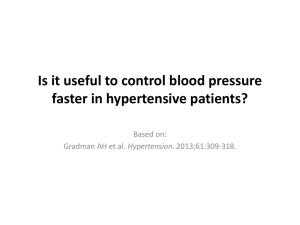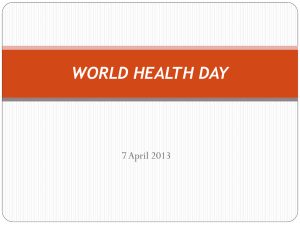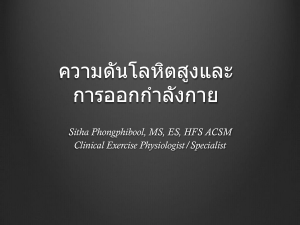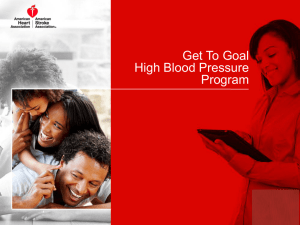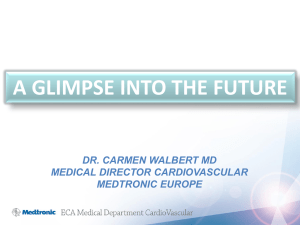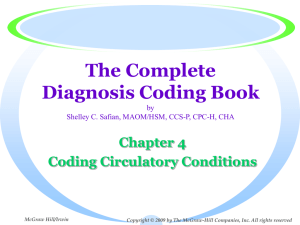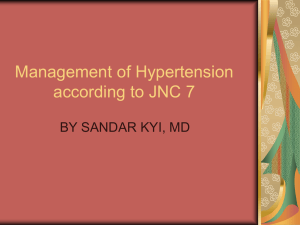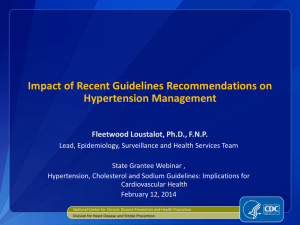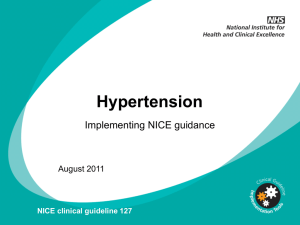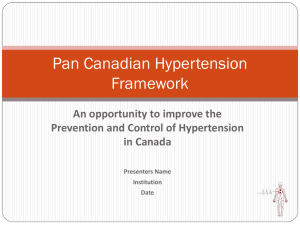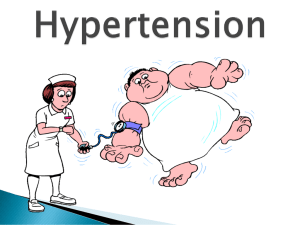Blood Pressure Management & Cardiovascular Health
advertisement
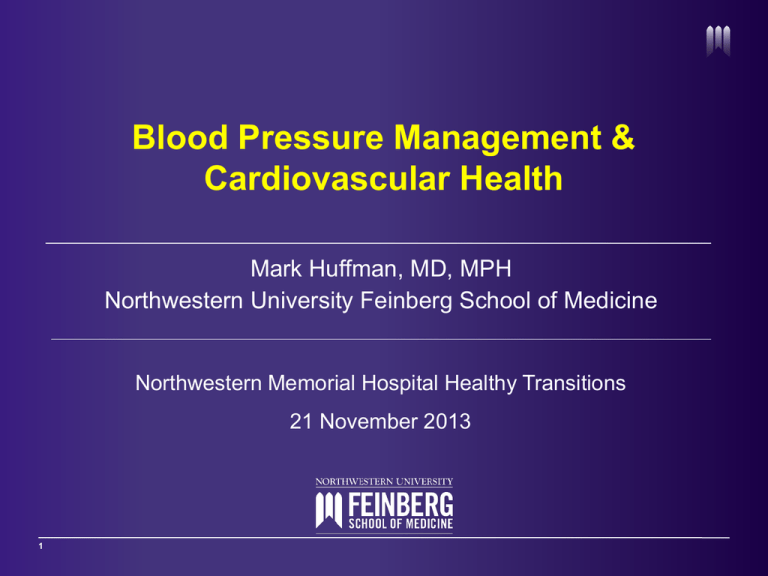
Blood Pressure Management & Cardiovascular Health Mark Huffman, MD, MPH Northwestern University Feinberg School of Medicine Northwestern Memorial Hospital Healthy Transitions 21 November 2013 1 Blood Pressure Management & Cardiovascular Health • Normal vs. optimal blood pressure: does it make a difference? • Raised blood pressure (hypertension) rates: Global, US, Cook County, and Chicago • Diagnosis and evaluation of hypertension • Management options: 2013 AHA/ACC/CDC guidelines 2 Blood Pressure Management & Cardiovascular Health • Normal vs. optimal blood pressure: does it make a difference? • Raised blood pressure (hypertension) rates: Global, US, Cook County, and Chicago • Diagnosis and evaluation of hypertension • Management options: 2013 AHA/ACC/CDC guidelines 3 Normal vs. Optimal Q1: What is a normal blood pressure? Q2: What is an optimal blood pressure? Q3: What was FDR’s blood pressure in 1945? 4 Normal vs. Optimal Q1: What is a normal blood pressure? “Normal” describes the bell-shaped distribution of a continuous measure, such as blood pressure within a population. 5 Blood Pressure Curves, US Women (2001-2008) 6 Wright J, et al. NCHS 2011. Average US Blood Pressure, Men 7 Wright J, et al. NCHS 2011. Average US Blood Pressure, Women 8 Wright J, et al. NCHS 2011. Observed SBP and Prevalence of BP Lowering Therapy (UK) Men Women Wills AK, et al. PLoS Med 8(6): e1000440. Normal vs. Optimal Q1: What is a normal blood pressure? Q2: What is an optimal blood pressure? Q3: What was FDR’s blood pressure in 1945? 10 Normal vs. Optimal Q2: What is an optimal blood pressure? “Optimal” describes the blood pressure that is associated with the greatest health outcomes, such as low rates of heart disease, strokes, or heart failure. (What is it? And over what time period?) 11 Optimal Blood Pressure ~115/75 12 Lewington S, et al. Lancet 2002;360: 1903–13. Age-Dependent? U-shaped Curve 13 Denardo S, et al. Am J Med 2010;123:719–26. Normal vs. Optimal Q1: What is a normal blood pressure? Q2: What is an optimal blood pressure? Q3: What was FDR’s blood pressure in 1945? 14 Normal vs. Optimal 15 Signs and Symptoms of Malignant Hypertension Evidence of end-organ damage: • • • • • Blurred vision (eyes) Headache (brain) Chest pain (heart) Shortness of breath, especially when lying down (heart) Kidney damage (kidneys) The rate of change in blood pressure tends to be more important than the absolute level due to the body’s ability to auto-regulate one’s blood pressure. 16 17 Blood Pressure Management & Cardiovascular Health • Normal vs. optimal blood pressure: does it make a difference? • Raised blood pressure (hypertension) rates: Global, US, Cook County, and Chicago • Diagnosis and evaluation of hypertension • Management options: 2013 AHA/ACC/CDC guidelines 18 Global Blood Pressure 2008 global average adult blood pressure Men: 128.1 mmHg (126.7, 129.4) Women: 124.4 mmHg (123.0, 125.9) Between 1980 and 2008, the average blood pressure decreased each decade by: 0.8 mmHg for men 1.0 mmHg for women 19 Danaei G, et al. Lancet 2011; 377: 568–77. 20 Danaei G, et al. Lancet 2011; 377: 568–77. US, Cook County, and Chicago Estimates of Hypertension: Institute for Health Metrics & Evaluation Chicago Health Atlas 21 Blood Pressure Management & Cardiovascular Health • Normal vs. optimal blood pressure: does it make a difference? • Raised blood pressure (hypertension) rates: Global, US, Cook County, and Chicago • Diagnosis and evaluation of hypertension • Management options: 2013 AHA/ACC/CDC guidelines 22 How is Hypertension Diagnosed? “The diagnosis of hypertension should be based on at least 3 different BP measurements, taken on 2 separate office visits to account for the natural variability of BP and other factors that can affect BP. “To confirm the validity and reliability of the measurement, at least 2 measurements should be obtained once the patient is comfortable and settled for at least 5 minutes. BP should be measured in the sitting position with the back supported, feet on the floor, arm supported in the horizontal position, and the BP cuff at heart level.” 23 Aronow WS, et al. Circulation 2011; 123:2434-2506. How is Hypertension Diagnosed? • Home blood pressure measurements are increasingly preferred as adjuncts to those taken in the doctor’s office. • Automatic sphygmomanometers work well; Omron, upper arm cuffs are preferred ($45-$65 on amazon.com) and are often covered by insurance. 24 myamericanheart.org How is Hypertension Evaluated? • Home blood pressure measurements are increasingly preferred as adjuncts to those taken in the doctor’s office. • Check your BP right after you get up in the morning (consistency helps reduce the number of variables). • On occasion, your doctor might ask you to wear a blood pressure cuff throughout an entire 24 hour period (ambulatory blood pressure monitoring) to check you blood pressure throughout the day. • You can enter via MyChart to share with your blood pressure with your doctor. 25 How is Hypertension Evaluated? 26 Blood Pressure Management & Cardiovascular Health • Normal vs. optimal blood pressure: does it make a difference? • Raised blood pressure (hypertension) rates: Global, US, Cook County, and Chicago • Diagnosis of and evaluation hypertension • Management options: 2013 AHA/ACC/CDC guidelines 27 Meta-Analysis: SHEP, Syst-Eur, Syst-China % Risk Reduction 20 0 All CV Mortality Mortality CV Events Stroke CHD -32% -37% -25% -20 -40 -60 -17% -25% ...and 50% reduction in CHF in SHEP! Staessen J, et al. Lancet 2000:355:865 NNT for 5 Years to Prevent 1 Event (NNT=number needed to treat) CV Event Stroke CHD All patients 26 48 64 Men 18 34 44 Women 38 68 92 Age 60-69 39 99 89 Age 70+ 19 32 50 Staessen J, et al. Lancet 2000:355:865 Hypertension in the Very Elderly Trial (HYVET) International multicenter trial; participants were ≥80 years Baseline SBP 160 to 199 mm Hg; target BP <150/<80 mmHg Randomized to indapamide 1.5 mg vs. placebo; could receive perindopril (2 or 4 mg) or placebo Primary outcome: Fatal or non-fatal stroke Secondary outcomes: Total mortality, CVD death, cardiac death, stroke death, fatal/NF heart failure NEJM 2008; 358:1887 Hypertension in the Very Elderly Trial (HYVET) 3845 participants; baseline blood pressure=173/91 mmHg Mean age = 83 years (range 80-105); 61% women; 12% with prior CVD Mean duration of F/U: 2 years (0 to 6.5 years) The trial was stopped early for significant reductions in primary endpoint and all-cause mortality NEJM 2008; 358:1887 Hypertension in the Very Elderly Trial (HYVET) BP 14.5/6.8 BP 29.5/12.5 NEJM 2008; 358:1887 Hypertension in the Very Elderly Trial (HYVET) 17.7/1000 p-y 12.4/1000 p-y 30% RRR; NNT 94 over 2 years NEJM 2008; 358:1887 Hypertension in the Very Elderly Trial (HYVET) 59.6/1000 p-y 47.2/1000 p-y 21% RRR; NNT 40 over 2 years NEJM 2008; 358:1887 2013 AHA/ACC/CDC Recommendations 35 Go AS, et al. J Am Coll Cardiol 2013; Nov 12. 2013 AHA/ACC/CDC Recommendations Systems-level approach to hypertension control, including: 1. 2. 3. 4. 5. Identifying all patients eligible for management Monitoring at the practice/population level Increasing patient and provider awareness Providing an effective diagnosis and treatment guideline Systematic follow-up of patients for initiation and intensification of therapy 6. Clarifying roles of healthcare providers to implement a team approach 7. Reducing barriers for patients to receive and adhere to medications as well as to implementing lifestyle modifications 8. Leveraging the electronic medical record systems being established throughout the US to support each of these steps 36 Go AS, et al. J Am Coll Cardiol 2013; Nov 12. Kaiser Permanente (2001-2009) 37 Jafffe MG, et al. JAMA. 2013;310(7):699-705 Lifestyle: Foundation of Management 38 Go AS, et al. J Am Coll Cardiol 2013; Nov 12. Hypertension Treatment Algorithm 39 Go AS, et al. J Am Coll Cardiol 2013; Nov 12. 40 Medications: Certain Circumstances Especially for patients with multiple medical problems, pill boxes help increase adherence to blood pressure lowering medications by ~10%. Only $5-$10 on amazon.com! 41 Go AS, et al. J Am Coll Cardiol 2013; Nov 12. Aged under 55 years Aged over 55 years or black person of African or Caribbean family origin of any age C2 A A+ C2 Summary of antihypertensive drug treatment Step 1 Step 2 A+C+D Step 3 Resistant hypertension Step 4 Key A – ACE inhibitor or low-cost angiotensin II receptor blocker (ARB)1 C – Calcium-channel blocker (CCB) D – Thiazide-like diuretic A + C + D + consider further diuretic3, 4 or alpha- or beta-blocker5 Consider seeking expert advice See slide notes for details of footnotes 1-5 Take Home Points: Management 43 • Home BP monitoring is preferred method of diagnosis and evaluation of treatment. • Use an automated BP machine (upper arm cuff) • Sign up for MyChart BP log • Lifestyle modification, particularly diet, can have a powerful effect on blood pressure. • Check out dashdiet.org for tips • Combination pills are being increasingly used to improve blood pressure control. • Use a pillbox to make taking your meds easier Blood Pressure Management & Cardiovascular Health Mark Huffman, MD, MPH Northwestern University Feinberg School of Medicine Northwestern Memorial Hospital Healthy Transitions 21 November 2013 44
